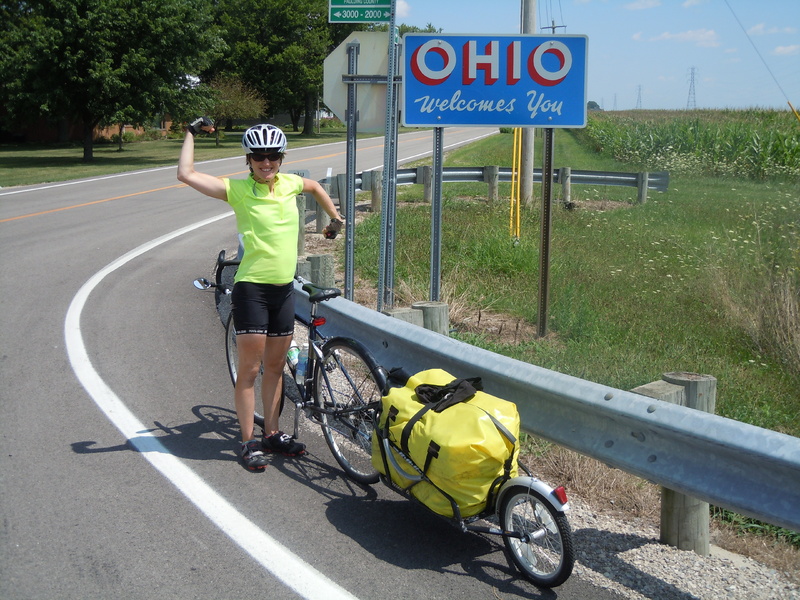Leah Trommer was in New York for her 30th birthday. But the long-awaited day wasn’t celebrated the way most milestones are, because cake and candles aren’t that important when you’re in the midst of a 4,000-mile, 54-day bicycle journey across the United States.
“It wasn’t your typical 30th birthday,” says Trommer, a Northport resident who was pedaling along the Erie Canal when her fourth decade arrived.
She had started pedaling in Anacortes, Wash., using a Northern Tier map from the Adventure Cycling Association (adventurecycling.org). Her solo adventure ended on Aug. 19, when she entered Fryeburg and then cycled on to her father’s home in Leeds.
“It was mixed emotions,” she says of her arrival back in Maine. “I felt really proud of myself and really excited and I guess excited to be home, but also kind of sad. It felt like the trip flew by to me.”
More than two months, parts of 15 states and so many nights spent in a tent and it flew by? Apparently, because Trommer is already planning next year’s summer vacation: the Great Divide Trail, from Canada to Mexico, on two mountain bike wheels.
“I’m drooling when I look at the map,” she says.
Trommer, who mentors middle school girls and works as assistant school program director for Tanglewood 4-H Camp & Learning Center, says she had a lot of fear before she embarked on her trip. Still, it didn’t take her many days to realize she could do this. Solo. And so can most semi-serious riders, thanks to Adventure Cycling Association, which does the legwork — well, except for the pedaling — for you.
purchasing a map from the association website, a cyclist has access to not only the route from point A to point B, but also the best spots to stop along the way, locations of bike shops, places to eat and options for lodging. “It’s an incredible resource,” says Trommer.
The map and information for the northern route she rode costs $102.50 for members and $137.50 for nonmembers. From there, a rider can spend as much or as little as he or she chooses. Trommer’s excursion cost her about $2,000, including airfare to Eugene, Ore., and the FedEx fee to ship her bike west.
She stayed mostly in campgrounds, but says she ran into many cyclists who camped in city parks for free. Many towns on the route were very welcoming to bikers, in particular Iroquois, Ill., population 300, where the mayor lets people stay in his air-conditioned office. The accommodations include a shower and free breakfast at the restaurant across the street.
“One whole wall of his office was just notes to the mayor from all the bicyclists who had come through,” Trommer says.
As a female on her own, Trommer says she didn’t always feel comfortable staying in public places, so she used caution and followed her intuition. Those who aren’t inspired to go it alone can look into guided tours offered at adventurecycling.org or by other tour companies, such as Maine Coast Cycling Adventures (trips across Maine and Canada), Coastal Biking Adventures (trips in New England and New York) and America Bicycle.
For those who want to hit the open road, Trommer has these tips:
• Try a mini-tour before tackling the whole country. Trommer soloed from Middlebury, Vt., to Maine last year to get herself started.
• Travel light. Trommer rode with a bike trailer that held just 35 pounds of gear to save wear and tear on her legs.
• Don’t over-ride before the trip. Trommer didn’t ride a lot during the spring, but is in the habit of exercising most days. Running, hiking and some biking gave her a good baseline of fitness.
• Know the winds. Because she rode west to east, Trommer says she almost always had a tailwind. She met riders going east to west who were frustrated and depressed because they were constantly pedaling into a headwind.
• Don’t be afraid to go solo. Trommer met up with other bikers and friends who rode with her for hours or days. She says it was the best of both worlds, because she could choose whether she wanted to be on her own or not.
• Ride toward home. Trommer was originally going to ride east to west, but an experienced biker told her that riding home is mentally a lot easier when you’re doing a point-to-point trek.
And one of the biggest pieces of advice Trommer imparts is about the why of a trip like this. Why get on a bike on one side of the country and stay on it until you get to the other?
“A big thing was being really set in why I wanted to do this,” she says. “It wasn’t a trip to say I had done it. It was about the journey and each day and what I came across and what I learned about myself.”
Deputy Features Editor Karen Beaudoin can be contacted at 791-6296 or at:
kbeaudoin@pressherald.com
Send questions/comments to the editors.



Success. Please wait for the page to reload. If the page does not reload within 5 seconds, please refresh the page.
Enter your email and password to access comments.
Hi, to comment on stories you must . This profile is in addition to your subscription and website login.
Already have a commenting profile? .
Invalid username/password.
Please check your email to confirm and complete your registration.
Only subscribers are eligible to post comments. Please subscribe or login first for digital access. Here’s why.
Use the form below to reset your password. When you've submitted your account email, we will send an email with a reset code.